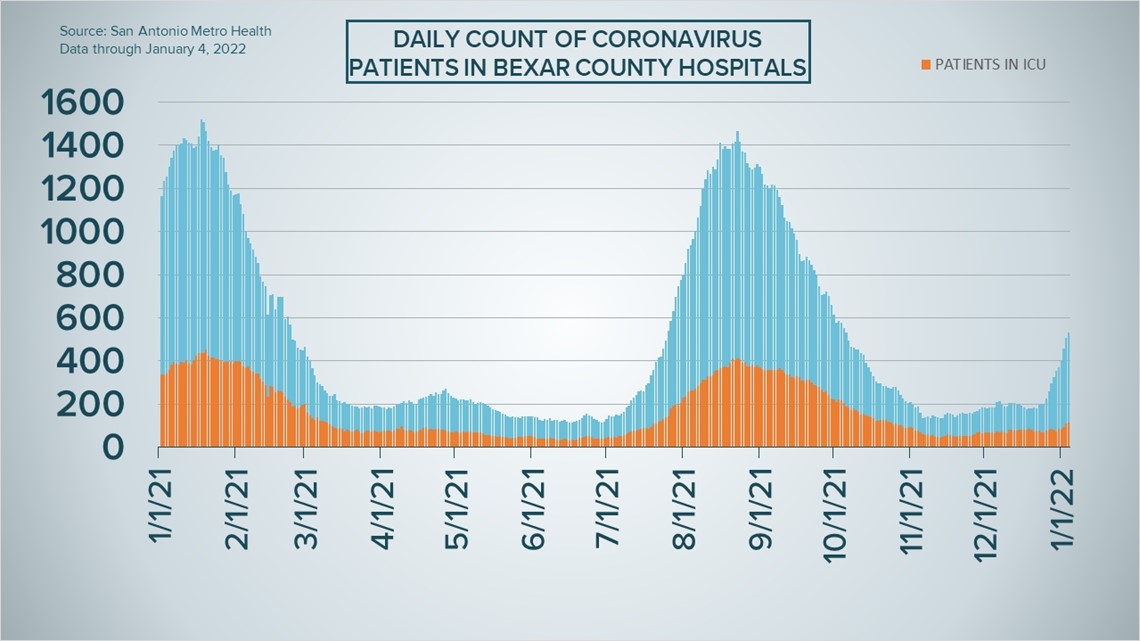SAN ANTONIO — San Antonio continues to see spiking COVID-19 case numbers to start the new year, with more than 4,300 new diagnoses reported by health authorities for only the second time in the pandemic. But the first, in July of 2020, included a huge case backlog aside from the ones tested that day.
Over the first four days of 2022, a total of 15,891 new cases have been reported, exacerbated by a highly contagious omicron strain and holiday gatherings.
In addition, 533 Bexar County residents were being treated for the virus at local hospitals, the highest that number has been since Oct. 5. And the seven-day moving average for new daily cases shot to a new pandemic-high of 2,545 on Tuesday, up from 2,055 the day prior.
However, the number of new deaths from COVID-19 complications remains relatively low, with just two fatalities reported since the week before Christmas. Nonetheless, the new surge has led to an increase in Texas children hospitalized with the virus.
Tuesday's new cases tally of 4,363 pushes the total number of Bexar County infections to 355,732 since the pandemic began two years ago.
On Monday, Mayor Ron Nirenberg told KENS 5 that residents need to remain vigilant and COVID-cautious as the pandemic continues. He specifically pointing to vaccinations, mask-wearing in crowded areas and staying home when sick as major tools to push through the prolonged health crisis.
The city continues to organize pop-up vaccine clinics as the immunization effort continues, while doctors try to deter people from hosting so-called "COVID parties" and universities consider their options amid the surge.
How Bexar County is trending




Coronavirus in Texas
The total number of coronavirus cases in the state since the pandemic began grew by 53,553 on Tuesday, according to the Texas Department of State Health Services. That total includes 44,431 new confirmed cases and 9,122 new probable cases. More details can be found on this page.
Tuesday's figures bring the total number of Texans diagnosed with COVID-19 to more than 4.798 million.
An additional 60 Texans have died from virus complications, meanwhile, raising the statewide death toll to 74,796.
Latest Coronavirus Headlines
- San Antonio doctor advises against 'COVID parties' amid surge in cases
- CDC approves Pfizer extra dose measures to increase access
- San Antonio tallies more than 11,000 COVID-19 cases over three days to start 2022
- The proper way to use at-home coronavirus test kits
- Here are the San Antonio universities delaying spring classes due to coronavirus concerns
- Is the party worth the risk? Soaring COVID cases lead to tough questions for New Year's Eve
Coronavirus symptoms
The symptoms of coronavirus can be similar to the flu or a bad cold. Symptoms include fever or chills, cough, shortness of breath or difficulty breathing, fatigue, muscle or body aches, headache, new loss of taste or smell sore throat, congestion or runny nose, nausea or vomiting, and diarrhea, according to the Centers for Disease Control.
Most healthy people will have mild symptoms. A study of more than 72,000 patients by the Centers for Disease Control in China showed 80 percent of the cases there were mild.
But infections can cause pneumonia, severe acute respiratory syndrome, kidney failure, and even death, according to the World Health Organization. Older people with underlying health conditions are most at risk.
Experts determined there was consistent evidence these conditions increase a person's risk, regardless of age:
- Chronic kidney disease
- COPD (chronic obstructive pulmonary disease)
- Obesity (BMI of 30 or higher)
- Immunocompromised state (weakened immune system) from solid organ transplant
- Serious heart conditions, such as heart failure, coronary artery disease, or cardiomyopathies
- Sickle cell disease
- Type 2 diabetes
- The CDC believes symptoms may appear anywhere from two to 14 days after being exposed.
Human coronaviruses are usually spread...
- Between people who are in close contact with one another (within about 6 feet).
- Through respiratory droplets produced when an infected person coughs, sneezes or talks. These droplets can land in the mouths or noses of people who are nearby or possibly be inhaled into the lungs.
- Some recent studies have suggested that COVID-19 may be spread by people who are not showing symptoms.
Help stop the spread of coronavirus
- Stay home when you are sick.
- Eat and sleep separately from your family members
- Use different utensils and dishes
- Cover your cough or sneeze with your arm, not your hand.
- If you use a tissue, throw it in the trash.
Find a Testing Location
City officials recommend getting a COVID-19 test if you experience fever or chills, cough, shortness of breath or difficulty breathing, fatigue, muscle or body aches, headache, new loss of taste or smell, sore throat, congestion or runny nose, nausea or vomiting, or diarrhea.
Here's a Testing Sites Locator to help you find the testing location closest to you in San Antonio.

